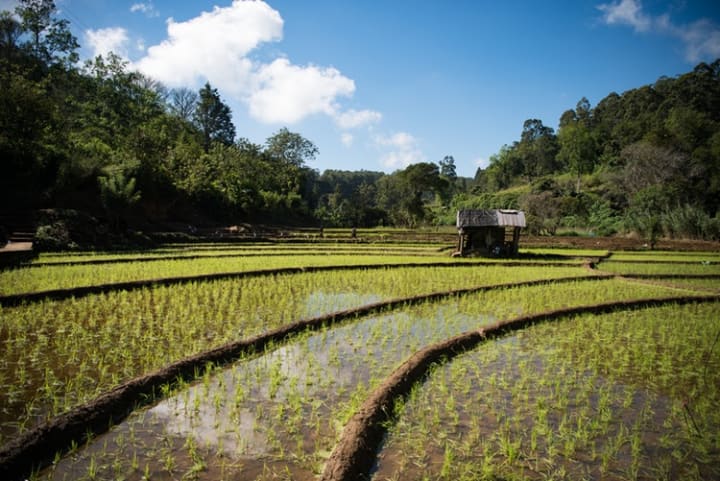The Ultimate Guide to Sake
Learn everything you need to know about sake, from the vocabulary terms associated with it to how to drink the Japanese beverage, with our helpful guide to sake.

Sake, sometimes denoted saké or referred to as Japanese rice wine, is an alcoholic beverage made from fermented rice. In Japan, sake refers to alcohol in general, whereas sake refers specifically to rice wine in countries outside of Japan.
Regardless of what you call it, the Japanese drink sake; or nihonshu, at holidays, special gatherings, and extravagant ceremonies; is similar to what Americans do with champagne.
Since you might be coming across sake soon in a local bar or Japanese restaurant as the sake fad further proliferates, it's important that you know more about this trendy adult beverage.
For that reason, let's discuss the history of sake, important terms related to sake you should know, the types of sake out there, how sake is made, and how to serve and consume sake, all wrapped up into our Ultimate Guide to Sake.
The Brief History of Sake

Remembering that sake in Japan refers to alcohol on a broad scale, sake as we know it outside of Japan can still be understood through its history.
Before we get started on the history of sake, sake doesn't just mean different things from the Japanese to the rest of the world (general alcohol versus rice wine); it can also refer to different things in different parts of Japan.
For example, sake was distilled from potatoes in former Southern Kyoto while it was distilled from sugar beets in Okinawa. However, today, sake is most often created from long types of rice.
When backtracking the origins of sake, there are actually two theories:
- Sake began in China in 4800 B.C. around the region of the river Yangtze, and shortly spread to Japan.
- Sake originated in the third century in Japan.
Regardless of where it started, we know that the beverage was, at first, produced in Japan for families and wealthier villages. As sake become more known, mass production became centered especially around present-day Kobe, still often consumed by the upper class.
It wasn't until around the 1300s that the mass production of sake in Japan made the beverage one of the most important drinks of the country. In fact, sake soon became (and still is) the national drink of Japan.
By the time Japan's Industrial Revolution of the nineteenth century came into play, the automation and mass production of sake grew even larger. In the twentieth century, the canvas bags originally used to squeeze yeast, koji mixture, and rice mash were often replaced with presses so that sake production became more mainstream.
As World World II rolled around, so did a rice shortage. Due to this shortage, the brewing process of sake was altered. To improve production and the brewing time, alcohol and glucose were added to the rice mash of sake.
Through the history of sake in Japan and the different methods of its production over the centuries, sake has been and still continues to be a crucial component of Japanese tradition, often signifying gathering and celebration.
Important Sake Terms
To better familiarize yourself with sake or rice wine, knowing the terms and types of sake is important. This cannot only help you better understand aspects of the Japanese culture, but also come to understand how sake is made.
General Sake Terms
- Sake: All types of alcohol to the Japanese
- Nihonshu: 'Japanese liquor;' refers to alcohol made from rice; what non-Japanese refer to as 'sake'
- Tokkuri: A tall container used to serve sake
- Sakazuki: 'Sake cup;' special cups used for weddings and special ceremonies in Japan
- Ochoko: 'Small cup;' 'sake cup'
- Guinomi: 'Sake cup'
- Choko: 'Sake cup'
- Polished rice: When rice is milled down; rice is polished during sake production.
- Koji: Cultured mold or fungus on steamed rice often used for fermentation
- Shubo: 'Mother of sake;' a mash composed of rice, water, and koji
- Fermentation (moromi): Chemical breakdown of microorganisms; what the rice in sake goes through during production
Types of Sake
- Junmai shu: Pure rice sake; no added ethyl alcohol
- Honjozo shu: Sake with a small amount of ethyl alcohol
- Ginjo shu: Sake with rice that's polished no more than 60 percent of its remains
- Daiginjo shu: Ginjo shu sake with rice polished no more than 50 percent of its remains
- Junmai ginjo shu: Ginjo sake without added ethyl alcohol, just as regular junmai sake lacks
- Junmai daiginjo shu: Daiginjo sake without added ethyl alcohol, just as regular junmai sake lacks
- Nama zake: Unpasteurized sake; all types of sake can be nama zake or namazake
How Sake Is Made

The most important part of sake production is its main ingredient: brown rice. Premium sake (all honjozo and junmai sake) is instead made with a special sake rice.
After the rice is harvested by farmers, it is hung and then later goes through a machine to remove the grains from the stems.
The rice kernels are then polished, or milled. The rice polishing ratio will depend on the type of sake produced.
Once the rice has been polished, the rice will be left to sit for about two weeks before it is washed and soaked, until the rice/water content reaches approximately 30 percent. After this process, the rice will be steamed, neither too much nor too little.
Once steamed, the rice will be cooled and moved onto the koji process, which is then followed by the shubo process, and then lastly, the fermentation process. Fermenting sake can take around 20 to 40 days, depending on the type of sake being made.
After fermentation, there are many other processes that occur before it can finally be served:
- Pressing
- Filtering
- Pasteurization #1
- Storing and maturing
- Diluting
- Pasteurization #2
- Bottling
With the lengthy and intricate sake brewing, it's no wonder why sake is so treasured in Japan! Fortunately for you, there are ways to make traditional sake in your own home.
How to Prepare and Serve Sake
One of the most important things to know before ordering sake is that different types of sake are often consumed at different temperatures. For instance, some types may taste best slightly warm or room temperature, whereas others may have their best flavor when drank cold.
It's recommended that junmai sake is served at room temperature or slightly chilled due to its high acidity. Premium sake, such as ginjo, are usually served warm. However, everyone may have a different idea of what tastes best.
For that reason, use your taste buds to guide your decision, or ask your server or bartender how a certain type of sake would best taste served.
Tips for Preparing Sake
- Warmed sake is best at just a pinch above the normal human body temperature. Serve at 100 to 104 degrees Fahrenheit (40 to 45 degrees Celcius).
- Refrain from making your rice wine too hot or too cold, especially repeatedly. This may distort the flavor and aroma of your beverage.
- Never heat your sake directly or too quickly (e.g., in the microwave). Slow and steady is key.
- If you want to chill your sake quickly without ruining the taste, wrap a wet cloth around the bottle, and place it in the freezer for about 20 minutes. (Don't forget about it!) You might instead wish to place it in an ice chest to cool it down.
- After opening a bottle of sake, keep the bottle out of direct light. For storage, place it in the refrigerator at 68 degrees Fahrenheit or lower. Refrigerated sake should be drunk within the next few days.
- Sake that is left out should be finished within two to three hours.
How to Serve Sake
It should come as no surprise that a drink with such a strong tradition and extensive production process should be revered, which is why there is a method behind learning how to drink sake the right way.
- Always pour sake for others, never for yourself.
- The server who's pouring sake from a larger serving container or tokkuri should hold it with both hands.
- Those you're serving to should hold their tiny sake cup (called an ochoko, guinomi, choko, or sakazuki; there are different styles/shapes of sake cups for different sakes) with both hands as well.'
- Tasting sake should be like tasting wine, taken in sips rather than quickly downed.
Sake, rice wine, or nihonshu is a beloved alcoholic beverage; however, many are unfamiliar with its background. From the history of sake to the terms associated with it to how it's made, prepared, and served, sake of all types is still closely linked with its Japanese roots.
After reading through our guide to sake, you'll be pretty much a sake expert. Now, all that's left is for your taste buds to experience the different flavors various sakes have to offer.
About the Creator
C.C. Curtis
Enjoys lounging in NYC bars, loves traveling to foreign countries, and volunteers at the homeless shelter twice a month.






Comments
There are no comments for this story
Be the first to respond and start the conversation.